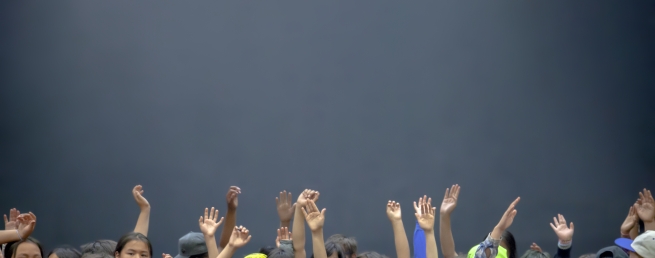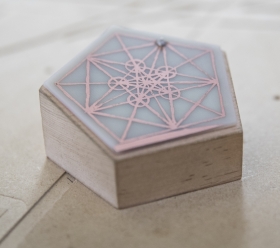I have often stopped to listen to the trees during a walk in a forest on a breezy day. Only recently, however, did I realize that it is possible to stop and listen to the fungi.
Mycelium is the underground network of fungal threads that connects the roots of different plants and provides a kind of communications service that researchers are still learning about. You need specialized gear to hear mushroom music, of course. In this issue, interdisciplinary artist Tosca Terán tells writer Greg J. Smith how she uses her DIY biosonification interface to translate the electrical activity of mycelium into MIDI notes, and how custom-made touchpads allow visitors to her gallery installations and workshops to join the circuit and, essentially, jam with fungi.
Tosca recorded the busily twinkling yet softly soothing music of a Dye Maker’s polypore (a mushroom) this fall in Dufferin Forest, Ontario; its song is included on the CD accompanying this issue. Let me know if the track reminds you of any human electronic-music composers.
A few years ago, composer, performer, and former Musicworks editor Tina Pearson alerted me to a fungal project of Experimental Music Unit (EMU), of which she is a member with Paul Walde, George Tzanitakis, and Kirk McNally, a Victoria, B.C., ensemble whose work informed the artistic direction of presenter LaSaM Music from 2012 to 2016. Music for Mycologists, EMU’s 2015 recording, featured mushroom-inspired and improv-informed compositions by the group, Walde (Musicworks 109), and Pearson. The ensemble’s concerts, not surprisingly, included works by John Cage.
You are probably asking yourself, What would John Cage make of all this? After all, the legendary avant-garde composer (who appeared in Musicworks many times) was an avid amateur mycologist, who actively collected, disseminated, and philosophized about mushrooms until his death in 1992. “I have come to the conclusion that much can be learned about music by devoting oneself to the mushroom,” he explained in his 1954 article “Music Lovers’ Field Companion,” published in United States Lines Paris Review. Although he noted similarities between foraging for mushrooms and finding ideas for works, he actually didn’t care about connecting with fungi on a musical level. “I am not interested in the relationships between sounds and mushrooms any more than I am in those between sounds and other sounds,” Cage wrote in the same article.
Tosca Terán may or may not know about the mushroom adventures of Cage or EMU, but now they are all connected via Musicworks—the kind of thing you notice from time to time when you’re editing a magazine about exploratory music, which has been around for forty years.
I felt the threads of the Musicworks network this fall while attending and following some of the exhibitions and events presented at the first annual Toronto Biennial of Art, September 21 to December 1. Daily Harbour Symphonies—original compositions for boat horns—have long been a tradition at Sound Symposium, an eclectic festival in St. John’s, Newfoundland, and an old friend of this magazine. Harbour Symphonies composed by Paul Steffler and by R. Murray Schafer in 1983, the first year of Sound Symposium, appear on one of the earliest Musicworks cassettes (issue 25, Side A). While attending the 2018 Symposium, composer Ravon Chacon (Musicworks 132) thought the concept could be a hit in his new home base, Toronto. And so, to kick off the biennial, composers Delf Maria Hohmann and Chacon, with Allison Cameron (Musicworks 122), John Oswald (Musicworks’ cofounder), and Marc Sabat (Musicworks 125), presented Harbour Symphonies at the Toronto Biennial, the inaugural theme of which was “The Shoreline Dilemma.”
One nippy Saturday afternoon, I cycled down to the Ontario Place Cinesphere to experience an hour or so of the biennale’s Saturday-only “The Drowned World,” which was curated by Charles Stankievech (Musicworks 106). The five-hour presentation includes readings, cinema, and sound art (spanning more than fifty years) that imagines the first bubbles and final evaporation of civilization. I got to hear a new surround-sound reimagining of composer and former Musicworks regular James Tenney’s 1969 composition For Ann (rising), a psychoacoustic work that gives the impression of continually climbing pitch—an eerie sonic sensation to experience while sitting yards away from the rising shoreline of Lake Ontario.
The Winter 2019 issue (MW 135) has many beautiful mycelium-like connections. Our cover story on Buffy Sainte-Marie’s groundbreaking electronic album Illuminations, also a 1969 work, includes comments from Chacon and Cris Derksen (Musicworks 121) and from Vancouver author Andrea Warner, who wrote the authorized biography of Buffy Sainte-Marie, published in 2018. Warner, whose work I’ve admired for some time, makes her Musicworks debut with a lovely story about Vancouver electronic-music composer and performer Kimia Koochakzadeh-Yazdi.
I trust you’ll enjoy foraging through Musicworks 135 for creative inspiration and connections.



